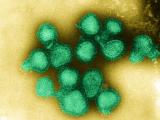The flu antiviral baloxavir can reduce flu transmission in households, raising the possibility that it could be used alongside other tools to reduce the annual burden of the disease and as a strategy in a pandemic setting, an international team of researchers reported yesterday in the New England Journal of Medicine.
About one third of flu transmission occurs in households, where the risk of transmission is as high as 38%. Given that antivirals can reduce virus shedding, researchers have hoped that the drugs can provide indirect protection to close contacts, but data are not definitive.
The team said households offer a unique setting to assess whether treating patients with baloxavir—known to stop shedding faster than oseltamivir—can also help curb transmission.
For their phase 3b double-blind, randomized, placebo-controlled trial, they enrolled 1,457 index patients who tested positive for flu within 48 hours of illness onset and 2,681 mostly unvaccinated household contacts at study sites in Bulgaria, the United States, Japan, China, and Turkey from October 2019 through April 2024. Among participants, 726 were assigned to the baloxavir group and given a single oral dose, and 731 were in the placebo group.
At day 5, transmission was significantly lower for the baloxavir group, with a relative risk reduction of 29% (95.38% confidence interval, 12% to 45%). Adjusted incidence was 9.5% for the baloxavir group compared to 13.4% for the placebo group. However, when the researchers looked at transmission by day 5 that resulted in symptoms, they found that the difference was not significant.
Emergence of drug-resistant viruses was found in 7.2% of the patients who got baloxavir, but none in any infected household contacts. No new safety signals were detected.
A potential role in pandemic settings
The team concluded that though vaccines remain the main control tool for flu, antiviral drugs could play a complementary role, especially in a pandemic setting, in treating patients and curbing transmission before a vaccine is available.
In a related editorial, three flu experts at the US Centers for Disease Control and Prevention (CDC) wrote that emergence of resistance to baloxavir has been a concern, and though transmission of resistant viruses has been remained rare, ongoing global surveillance is essential.
They also note that questions still remain about how to most effectively use antiviral medications, with clinical trials needed to gauge their role in controlling institutional flu outbreaks, such as in nursing homes. The scientists added that during the early phase of a flu pandemic, baloxavir might have a greater transmission reduction benefit than for seasonal flu, because most people will lack immunity to the new virus and household transmission would likely be high.



















